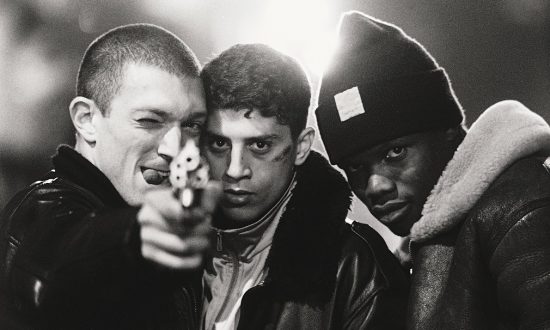Review: La Haine – “One of French cinema’s (not so) hidden gems.”
Exactly 21 years ago, The Hate (French: La Haine) one of the most iconic and influential films in modern French cinema, was released. You might have heard the name Mathieu Kassovitz for his role in the film Amèlie (2001), possibly the most iconic French film ever, but before Amèlie was even a concept, the at the time 28 year old Kassovitz dared to make a film about the social injustice, discrimination and violence going on in his country. He felt the urge to make the film after a young man from a Parisian housing project was shot and killed by a policeman, while handcuffed and in custody. The Hate is not only a reflection of the social situation that France was (and still is) going through in terms of racism and lack of integration for their minority groups, but it also serves as a universal message about the dangers of the oppression and misrepresentation of such ethnic groups.
Three friends; Vince, Hubert and Saïd, who live in a housing project in the Parisian suburbs, find a policeman’s lost gun in the aftermath of a series of riots against the police around the city. The film narrates the 19 hour period the day after the riots, during which these three young men from different ethnic minority groups await news about their friend Abdel, who was badly injured by policemen during the riots. Their different personalities start to clash as rage starts to consume Vince, who swears to kill a cop with the gun they found if Abdel were to die in the hospital.
The film is an artistic display on so many levels. Probably the first thing that goes through your mind when the movie starts is why is it in black and white? It is worth noting though, that it wasn’t planned as a black and white film, this was actually done during post production, as Kassovitz felt this would make the film’s message more powerful. Is Kassovitz criticizing racism by saying that we should be “colorblind”? Is it intended to give the film a kind of neo-noir atmosphere, reinforcing the worn down look of the projects and the fact that they aren’t taken care of by the government, or anyone for that matter? In any case, it makes for a very visually compelling film that shows the abilities of cinematographer Pierre Aïm and the editing team behind the colour correction process on full display. Growing up in a poor housing project himself, Kassovitz felt strongly about the messages he tries to convey. The mise-en-scene all throughout the film is carefully and deliberately set to achieve a purpose; graffiti with hidden messages, clothes hanging from windows, old and rusty playing areas and a general sense of hostility are all part of Kassovitz’s careful attention to detail in order to involve the audience as much as possible and make them feel, much like the main characters (especially Hubert, who dreams of living away from the projects) trapped inside the projects. It also furthers the character development that Kassovitz does so effectively, from the costume design to the masterfully written script that makes the conversations seem so natural and realistic that you forget that you’re watching actors playing a role.
Part of Kassovitz’s strategy to create a film that would reflect a social reality so accurate and realistically, was using mostly non-professional actors, giving the film a genuine feel, almost as if we’re watching a documentary (which is something Kassovitz wanted the audience to feel). Nevertheless, despite being non-professionals, I couldn’t help but marvel at some of the performances that the actors gave. There is a scene where Vinz is talking to a very young boy, who starts telling him a story- this scene goes on for about 2 minutes without cutting, while the kid spurts out line after line seamlessly- testament to Kassovitz’s excellent directing and finding a talented cast without having to use big name actors. The three lead roles, played by Vincent Cassel, Hubert Koundé and Said Taghmaoui, are nothing short of spectacular either. They bring their characters to life in such a way that most of the time the film seems unscripted. Because most of the film’s weight falls on the shoulders of the three leads, Kassovitz took his time to find actors worthy of those roles. Their character’s carefully crafted personality plays a key role in the narrative’s progression; Vinz’s hotheaded, short tempered nature clashes with Hubert, the more calm and reasonable of the bunch, while the loyal Saïd serves as a sort of intermediary between the two. This performance by Cassel is what made him rise to stardom and become a household name in French cinema as a tough guy, and then went on to become a very well-known actor in the English speaking world as well (Ocean’s Twelve, Black Swan, Jason Bourne). Although Koundé and Taghmaoui never got the same exposure as Cassel did after the film, it nonetheless launched their acting careers a great deal further.
Winner of the 1995 Cannes Film Festival for ´Best Film´, La Haine is a brutally honest depiction of some of our society’s most prevalent issues, such as police brutality and young violence. Although it’s very specifically set during the riots that were happening in Paris at the time, the film resonates all around the world thanks to its statements about oppression, revenge and the desire “to be heard.” It’s a sublime film that served as a platform for Kassovitz and Cassel’s talent to be recognized by a mainstream audience. Its virtually flawless execution and unforgettably climatic ending makes it a must-see not only for fans of French or international cinema, but for anyone who’s willing to spend an hour and a half of their time watching one of the most thought-provoking films of the 90s.
You can follow me on Instagram.











Ready to see the movie!